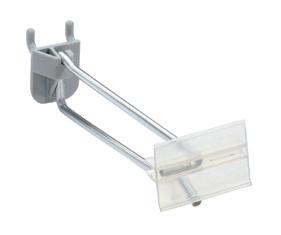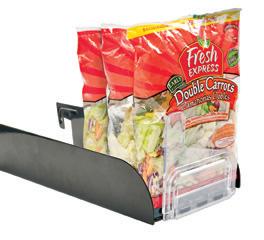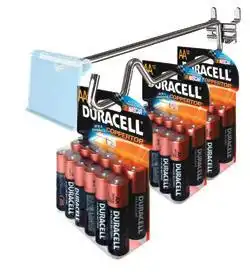
3 minute read
Fixture Management Considerations
from PG_0323
by ensembleiq
WHEN IT COMES TO MERCHANDISING and displays, selecting the right fixture for the job cannot be understated, especially as the footprints of retail stores are getting smaller and retailers are required to do more with less. Eric Chiang of Perfect Fit Meals says retailers who take a flexible approach to fixtures and displays will help brands that are seeking to develop an effective merchandising plan within the store environment. “If built in—if they’ve already designed these stores to be very modular in nature—it’s that much easier for brands to come in and plug in because it’s like a common frame that we’re all working from. And it’s cost effective for the retailer because they’re not over-investing in sets of fixtures that may change out every six months or a year,” he explains.
Chiang adds that modular fixtures can help streamline merchandising programs in terms of restocking, making the process much more easily managed. Perfect Fit Meals utilizes vertical fixtures with horizontal push trays, which aren’t new, per se, but maximize floor space and allow for ease of inventory changeout without adding significant costs.

The industry is following suit with the modular fixture trend, according to the Industry Size & Composition study. Sought-after features across many channels include flexible products, as well as those that are easy and inexpensive to update. Mobility allows retailers to avoid sparsely stocked fixtures during inventory fluctuations and gives them the flexibility to focus on and adjust the store layout as they see fit.
To help retailers select the right fixture for the job, Brad W. Cox, director of sales and marketing, and Rich Wildrick, director of engineering for Trion Industries, Inc. offer the following considerations for several fixture-type categories:
STRAIGHT ENTRY HOOKS—These fixtures are used for a few reasons: one is to be able to easily place display hooks tightly under shelves without needing to remove the shelves to do so. Standard display hooks need to be steeply angled up to place them in a peg board, whereas straight entry hooks (either one- or two-piece) can be placed straight into the board, hence the name. Straight entry also allows the tightest display and maximum product density throughout the display, not just under shelves.The other reason retailers use straight entry hooks is because it gives them an easier way to change a planogram as they can move a fully stocked hook instead of having to remove the product, as with a standard peg hook that needs to be angled up to remove and replace in the board.

SHELF MANAGEMENT SYSTEMS—Shelf management systems are used to assist in organization by keeping items in their own lane as they are shopped. Spring feed pushers can be added to keep the merchandise pushed forward to the shelf edge for best visibility. Some items cannot stand on their own due to packaging constraints, but by using shelf management a retailer can stand the item up to billboard the marketing information printed on the packaging
(bagged frozen vegetables, for example). Shelf management can also be used to limit shelf stock. By using a pusher system shorter than the shelf, a retailer can keep the appearance of the shelves looking full until the last item is sold, which leads to another benefit of shelf management: when a product is sold out it can be easily identified by the retailer to be restocked. Bar merchandisers come in many forms, from thin crossbar to square and rectangular tubing, and often allow tighter vertical spacing with less wasted space than shelves. Simple systems use hooks to merchandise items, while more intricate merchan dising trays can be used to offer better product management.

SCAN HOOKS—Scan hooks are the primary fixture used to merchandise most hanging or carded items in retail. They consist of a lower merchandising arm and an upper arm that holds the scanning tag (price label) in front of the product for easy identification. The most sophisticated scan hook approaches include flatback backplates to avoid marring the display surface, flip front label holders that swing up for better product access, forward staging areas to billboard visual presentation, and simple, anti-theft profiles to prevent “sweeping” or mass theft of multiple items.
These types of fixtures, among others, can result in a number of benefits for including: increased sales, maximum visibility, enhanced package billboarding, proper product rotation, and increased facings.
Additionally, Cox suggests retailers look for several characteristics when making fixture management considerations. “Retailers should be looking to partner with an experienced fixture provider who is well versed in all aspects of merchandising. Fixtures should be consistent in quality, so planograms will look uniform when implemented from store to store,” he explains.
It is important to find a manufacturer who has multiple solutions to meet all a retailer’s needs from display hooks, bin systems, dividers, pushers, shelf management systems, and more. Of course, cost is another driving factor, so retailers need to be sure that corners are not being cut to reduce fixture prices that will end up costing them more money down the road. “We have seen reduced diameter wire display hooks not hold up and label holders yellow under UV lighting that was caused by inferior materials being used to reduce costs, when if they would have spent a little more upfront they would have gotten extended use, lower life cycle cost, and better consistency in these types of items,” Wildrick notes.











